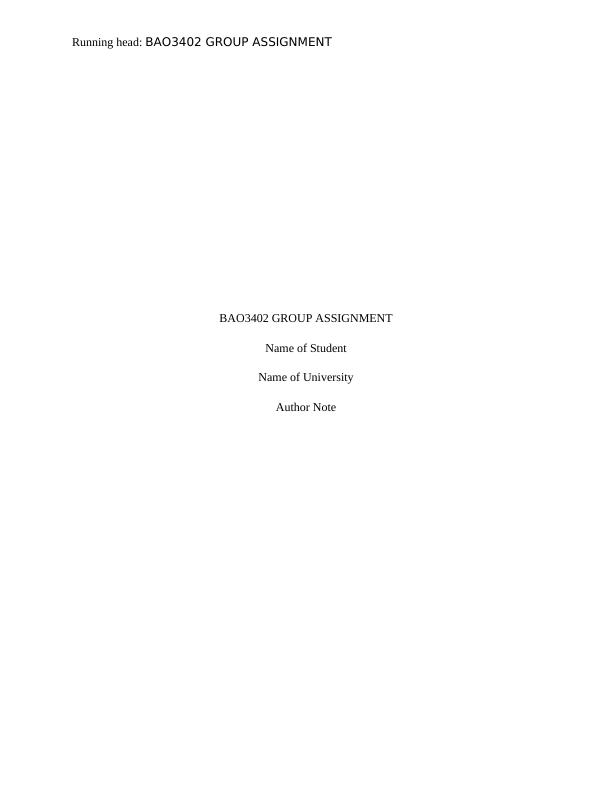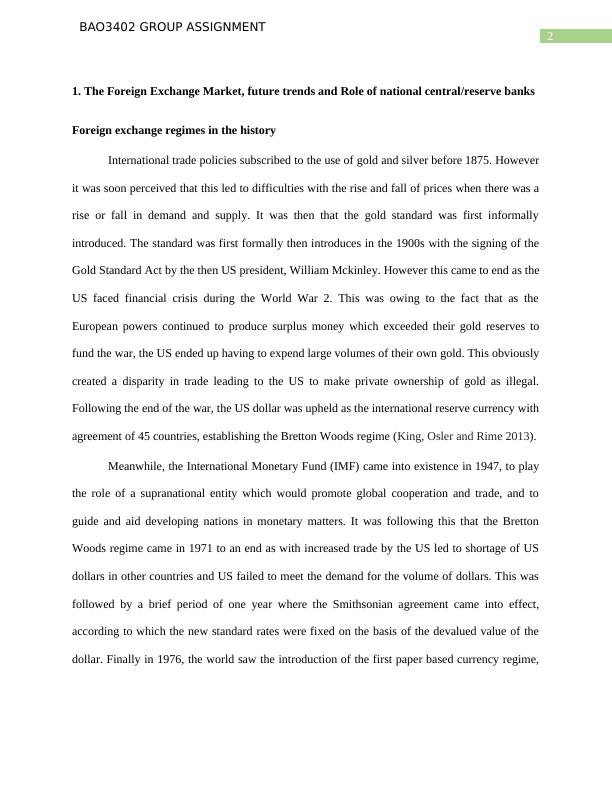Foreign Exchange Market: Trends, Role of Central Banks & Analysis of Exchange Rates
Added on 2023-06-08
14 Pages3362 Words286 Views
Running head: BAO3402 GROUP ASSIGNMENT
BAO3402 GROUP ASSIGNMENT
Name of Student
Name of University
Author Note
BAO3402 GROUP ASSIGNMENT
Name of Student
Name of University
Author Note

1
BAO3402 GROUP ASSIGNMENT
Table of Contents
1. The Foreign Exchange Market, future trends and Role of national central/reserve banks..........3
2. An Exercise in Analysis of Foreign Exchange Rates..................................................................7
Reference.......................................................................................................................................14
BAO3402 GROUP ASSIGNMENT
Table of Contents
1. The Foreign Exchange Market, future trends and Role of national central/reserve banks..........3
2. An Exercise in Analysis of Foreign Exchange Rates..................................................................7
Reference.......................................................................................................................................14

2
BAO3402 GROUP ASSIGNMENT
1. The Foreign Exchange Market, future trends and Role of national central/reserve banks
Foreign exchange regimes in the history
International trade policies subscribed to the use of gold and silver before 1875. However
it was soon perceived that this led to difficulties with the rise and fall of prices when there was a
rise or fall in demand and supply. It was then that the gold standard was first informally
introduced. The standard was first formally then introduces in the 1900s with the signing of the
Gold Standard Act by the then US president, William Mckinley. However this came to end as the
US faced financial crisis during the World War 2. This was owing to the fact that as the
European powers continued to produce surplus money which exceeded their gold reserves to
fund the war, the US ended up having to expend large volumes of their own gold. This obviously
created a disparity in trade leading to the US to make private ownership of gold as illegal.
Following the end of the war, the US dollar was upheld as the international reserve currency with
agreement of 45 countries, establishing the Bretton Woods regime (King, Osler and Rime 2013).
Meanwhile, the International Monetary Fund (IMF) came into existence in 1947, to play
the role of a supranational entity which would promote global cooperation and trade, and to
guide and aid developing nations in monetary matters. It was following this that the Bretton
Woods regime came in 1971 to an end as with increased trade by the US led to shortage of US
dollars in other countries and US failed to meet the demand for the volume of dollars. This was
followed by a brief period of one year where the Smithsonian agreement came into effect,
according to which the new standard rates were fixed on the basis of the devalued value of the
dollar. Finally in 1976, the world saw the introduction of the first paper based currency regime,
BAO3402 GROUP ASSIGNMENT
1. The Foreign Exchange Market, future trends and Role of national central/reserve banks
Foreign exchange regimes in the history
International trade policies subscribed to the use of gold and silver before 1875. However
it was soon perceived that this led to difficulties with the rise and fall of prices when there was a
rise or fall in demand and supply. It was then that the gold standard was first informally
introduced. The standard was first formally then introduces in the 1900s with the signing of the
Gold Standard Act by the then US president, William Mckinley. However this came to end as the
US faced financial crisis during the World War 2. This was owing to the fact that as the
European powers continued to produce surplus money which exceeded their gold reserves to
fund the war, the US ended up having to expend large volumes of their own gold. This obviously
created a disparity in trade leading to the US to make private ownership of gold as illegal.
Following the end of the war, the US dollar was upheld as the international reserve currency with
agreement of 45 countries, establishing the Bretton Woods regime (King, Osler and Rime 2013).
Meanwhile, the International Monetary Fund (IMF) came into existence in 1947, to play
the role of a supranational entity which would promote global cooperation and trade, and to
guide and aid developing nations in monetary matters. It was following this that the Bretton
Woods regime came in 1971 to an end as with increased trade by the US led to shortage of US
dollars in other countries and US failed to meet the demand for the volume of dollars. This was
followed by a brief period of one year where the Smithsonian agreement came into effect,
according to which the new standard rates were fixed on the basis of the devalued value of the
dollar. Finally in 1976, the world saw the introduction of the first paper based currency regime,

3
BAO3402 GROUP ASSIGNMENT
when the IMF abolished gold in totality as a reserve asset as per the Jamaica Agreement and
formally established the floating exchange rate regime.
Foreign Exchange Rate Systems
Exchange rate systems can be categorized as per the degree of its “fixity” or “flexibility”.
Currently, there exists a total of 9 kinds of rating systems as per the policies of the governments
of the countries. These systems are primarily monitored and controlled by the monetary
authorities of the respective countries. These 9 regimes can be broadly divided into 3 groups as
per the degree of “fixity”.
Fixed arrangements are those which have a fixed standard exchange rate, either against a
specific value, or with respect to another currency such as the US dollar which are called dollar
pegs. Examples of such arrangements would be the CFA franc zone, which is truly fixed, the
European Union is another example, referred to as a currency union where the member countries
share the same currency. Another kind of fixed regime is a currency board, where the total asset
reserves are kept in a foreign currency equivalent to the local monetary base, by the monetary
authority (Cooper 2014). This is what the British and French did during the colonization age in
their colonial territories.
Intermediate arrangements in comparison to the fixed arrangement regimes, involve
adjustable “pegs”. Such arrangements periodically or as per convenience tend to adjust or change
the standard rates or pegs. The rate regimes, adjustable pegs, crawling pegs, basket pegs and
target zone or bands fall under this category or exchange rate regimes. Adjustable peg systems
periodically modify their pegs, basket peg on the other hand fixes the peg as a weighted measure
of a set of foreign currencies. Crawling pegs engages in changing the currency rate through
devaluating the currency serially. Countries employing target zone system have a pre-determined
BAO3402 GROUP ASSIGNMENT
when the IMF abolished gold in totality as a reserve asset as per the Jamaica Agreement and
formally established the floating exchange rate regime.
Foreign Exchange Rate Systems
Exchange rate systems can be categorized as per the degree of its “fixity” or “flexibility”.
Currently, there exists a total of 9 kinds of rating systems as per the policies of the governments
of the countries. These systems are primarily monitored and controlled by the monetary
authorities of the respective countries. These 9 regimes can be broadly divided into 3 groups as
per the degree of “fixity”.
Fixed arrangements are those which have a fixed standard exchange rate, either against a
specific value, or with respect to another currency such as the US dollar which are called dollar
pegs. Examples of such arrangements would be the CFA franc zone, which is truly fixed, the
European Union is another example, referred to as a currency union where the member countries
share the same currency. Another kind of fixed regime is a currency board, where the total asset
reserves are kept in a foreign currency equivalent to the local monetary base, by the monetary
authority (Cooper 2014). This is what the British and French did during the colonization age in
their colonial territories.
Intermediate arrangements in comparison to the fixed arrangement regimes, involve
adjustable “pegs”. Such arrangements periodically or as per convenience tend to adjust or change
the standard rates or pegs. The rate regimes, adjustable pegs, crawling pegs, basket pegs and
target zone or bands fall under this category or exchange rate regimes. Adjustable peg systems
periodically modify their pegs, basket peg on the other hand fixes the peg as a weighted measure
of a set of foreign currencies. Crawling pegs engages in changing the currency rate through
devaluating the currency serially. Countries employing target zone system have a pre-determined

End of preview
Want to access all the pages? Upload your documents or become a member.
Related Documents
Collapse of Post Bretton Woods Monetary Systemlg...
|5
|744
|78
GLOBAL ECONOMY.lg...
|4
|428
|35
Exchange Rate Evaluationlg...
|4
|586
|205
Macroeconomics: Understanding US Trade Deficit and Balance of Paymentslg...
|11
|2486
|348
Macroeconomics Assignment 2022lg...
|7
|1779
|18
International Finance: Currency Crisis, Asian Financial Crisis and Aftermathlg...
|10
|2424
|158
